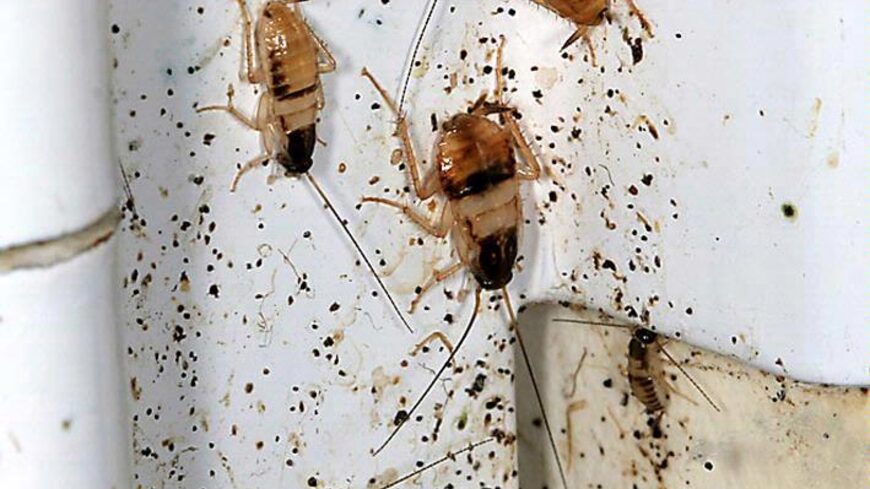Cockroaches are among the most common insects in the world. During the Carboniferous Period, some 2 million years ago, they were present in huge populations and some were several inches long. Thank goodness their size has scaled down dramatically over the eons. With over 3,500 species in existence today -- over 55 species alone in North America -- cockroaches are clearly one of the most highly adaptable of all insects having survived myriad environmental changes. Only a few of the species in Canada inhabit our dwellings, most commonly:
- German cockroach
- American cockroach
- Oriental cockroach
- Brown-banded cockroach
- Smoky brown cockroach
- Australian cockroach
- Brown cockroach
- Woods cockroach
- Field cockroach
- Lobster cockroach
Over the years, we have encountered most of these species in a variety of residential and commercial environments -- Australian roaches at a zoo, American roaches in the basements of several large commercial buildings in downtown Toronto, wood roaches in cottages in Haliburton and German and brown-banded roaches in apartment buildings and homes.
German Cockroach Life Cycle, Identification and Behaviour
All cockroaches develop by gradual metamorphosis, thus have an incomplete metamorphosis. Their life cycle consists of only three stages; egg, nymph and adult. The female produces a purse-shaped case, called the ootheca, which has two rows of eggs inside.
Why the German Cockroach is the Most Common House-infesting Roach
The German cockroach [Blattella germanica (Linnaeus)] is the most common roach encountered in homes in North America probably due to its higher reproductive potential. They produce a larger number of eggs per capsule with shorter hatching times than do the other species. As well, they have a shorter period from hatching until sexual maturity, so that within a given period of time a population of German roaches will produce a larger number of eggs. Since the female carries the egg capsule during nearly the entire time that the embryos are developing within the egg, many hazards of the environment which may affect the eggs are avoided. This means that more nymphs are likely to hatch and that a larger portion of the reproductive potential is realized.
The group's survival may also be attributed to the way the nymphs tend to stay close to each other, and since they are often close to the female at the time of hatching, there is a tendency for the population density to be high locally. Being smaller than most of the other cockroach species, German roaches are able to conceal themselves in many places which are inaccessible to individuals of the larger species. Finally, the German roach has a widespread occurrence of resistance to insecticides.
Identification
German cockroach adults are pale brown and about 1/2-inch long. Both sexes have wings as long as their body and they can be distinguished from other roaches by two dark stripes on the pronotum. Young German cockroaches (nymphs) resemble the adults except they are smaller, wingless and darker in color, often nearly black. A single light stripe running down the middle of the back is the most prominent marking on the young cockroach.
Reproduction
The female carries her egg capsule protruding from her abdomen until the eggs are ready to hatch. The egg capsule is slender, about 1/3-inch long and tan in color. The nymphs may break open the capsule while it is still attached to the female or she may deposit the capsule in some protected place where the young will be able to find food when they hatch. A female will usually produce 4 to 8 capsules in her lifetime. Each capsule contains 30 to 48 eggs which hatch out in about 28 days at room temperature. It's easy to see how cockroach populations can quickly get out of control. The completion of the nymphal stage under room conditions requires 40 to 125 days and the nymph usually molts 7 times before reaching adulthood. German roaches may live as adults for approximately one year.
Habits and Behaviour
Nymphs have habits similar to those of the adults. They dislike light and hide in dark cracks and crevices during the day and are active at night. If German roaches are seen during the day or while there is human activity in the area, then the population is so large that the available cracks are already full. They usually hide in areas close to moisture and food which means kitchens and other food areas. They appear to prefer to rest on wood rather than on metal or other smooth surfaces. Large infestations do occur on metal surfaces when there are few other surfaces available such as in a submarine or a large, modern food processing plant with stainless steel equipment.
The German roach is a general feeder but seems to prefer fermented foods. If the adults have water they can live about a month without food, but young nymphs die of starvation within ten days. Without food or water, the adults die in less than two weeks.
Infestations are sometimes found in areas not generally suspected of German roaches, for example, dresser drawers in bedrooms. When they are found scattered through non-food areas of a home or building, it is evidence of large infestations. Roaches in areas away from food sources live on crumbs, soiled clothing and the glue on dresser drawers. German roaches are also found outdoors during warm months around heavily infested homes and buildings and can be observed in and around garbage receptacles.
The German cockroach is very active. Both the male and the female adults are fully winged although they rarely fly. They are carried from place to place in such things as bagged potatoes and onions, bottle cases and cartons, food packages and even women's hand bags.They travel readily from one location to another and can pass through very small openings. Cockroach habitat is characterized by a number of environmental factors such as, small cracks and crevices or small openings into dark, confined areas that are moist, located near a source of water and a source of food supply.
German roaches are usually found clustered closely together. However, in populations that have developed a resistance to insecticides, individuals may scatter widely throughout a building. This scattering effect results in distribution of individuals that are not quickly or easily found which can breed and build up the populations again in a short time.
Brown-banded Cockroach Life Cycle, Identification and Behaviour
The brown-banded cockroach [Supella longipalpis (Serville)] is one of the smaller roaches that we often encounter in homes and apartment suites.They are rarely over 1/2-inch long, light brown in colour and readily distinguished from the German cockroach by the presence of two lighter, transverse (running from one side to the other) bands across the base of the wings and abdomen in the adults and nymphs. These bands may be somewhat irregular or broken and are more pronounced on the young and the female than on the males. The female is much broader bodied than the male. Both male and female are quite active and the adult males fly readily when disturbed, unlike German roaches which rarely take flight.
Both adults and nymphs may jump when attempting to escape. They frequently occur in the same buildings as the German roach and we need to identify which species we're dealing with because there are some differences in the control measures we take.
A female brown-banded roach carries her egg capsule for a day or two and then attaches it to a protected surface. The egg case is purse-shaped, light brown and is cemented in place, usually to the side or under surfaces of infested objects. Each female produces about 14 capsules during her adult life, each containing approximately 18 eggs. These hatch in 50 to 75 days, depending on temperature. Under room conditions, nymphs mature in about 160 days. Adults may live up to 10 months.
Nymphs and adults are generally found on ceilings, high on walls, behind picture frames and near motors of refrigerators and other appliances. They are also found in light switches, closets and furniture. They do not require as much moisture as the German roach does, which helps explain why they are normally found in rooms other than the kitchen or bathroom. These roaches, like German roaches, also dislike light and are not normally seen during the day.
The brown-banded roache's favorite food seems to be starchy materials bcause of the areas where they are normally found. However, they can also be found feeding on almost anything and have been known to chew on non-food materials such as nylon stockings.
When we look for evidence of brown-banded roaches, we look beneath tables and chairs, dressers and chests, behind pictures, along room molding, on rough plaster walls and ceilings and most expecially on the ceilings and upper walls of cabinets, pantries and closets. No room is spared, nor any piece of wood, metal or upholstered furniture if its construction provides harborage. Tiny black droppings and cast off skins are dead giveaways that brown-banded roaches are active in that area and can be found on shelves and ledges below where the roaches hang around.
We find brown-banded roaches more in homes, apartment buildings, hotel and hospital rooms than in stores, restaurants and kitchens. They are rapidly transported in furniture and quickly spread throughout a building. Originally abundant in the warm, southern US, they have been in cooler Canada now for years, inhabiting the warmer parts of buildings and homes.



